I faced a similar problem. I used layers instead of views for the animation. You could try something like this.
- Draw each element as a CALayer and include them as sublayers for your container UIVIew's layer. UIViews are easier to animate, but you will have less control. Notice that for any view you can get it's layer with [view layer];
- Create a custom sublayer for your quadrilateral. This layer should have a property or several of properties you want to animate for this layer. Let's call this property "customprop". Because it is a custom layer, you want to redraw on each frame of the animation. For the properties you plan to animate, your custom layer class should return YES needsDisplayForKey:. That way you ensure -(void)drawInContext:(CGContextRef)theContext gets called on every frame.
- Put all animations (both circles and the quad) in the same transaction;
For the circles you can probably use CALayers and set the content, if it is an image, the standard way:
layer.contents = [UIImage imageNamed:@"circle_image.png"].CGImage;
Now, for the quad layer, subclass CALayer and implement this way:
- (void)drawInContext:(CGContextRef)theContext{
//Custom draw code here
}
+ (BOOL)needsDisplayForKey:(NSString *)key{
if ([key isEqualToString:@"customprop"])
return YES;
return [super needsDisplayForKey:key];
}
The transaction would look like:
[CATransaction begin];
CABasicAnimation *theAnimation=[CABasicAnimation animationWithKeyPath:@"customprop"];
theAnimation.toValue = [NSValue valueWithCGPoint:CGPointMake(1000, 1000)];
theAnimation.duration=1.0;
theAnimation.repeatCount=4;
theAnimation.autoreverses=YES;
theAnimation.timingFunction = [CAMediaTimingFunction functionWithName:kCAMediaTimingFunctionEaseIn];
theAnimation.delegate = self;
[lay addAnimation:theAnimation forKey:@"selecting"];
[CATransaction setValue:[NSNumber numberWithFloat:10.0f]
forKey:kCATransactionAnimationDuration];
circ1.position=CGPointMake(1000, 1000);
circ2.position=CGPointMake(1000, 1000);
[CATransaction commit];
Now all the draw routines will happen at the same time. Make sure your drawInContext: implementation is fast. Otherwise the animation will lag.
After adding each sublayer to the UIViews's layer, rememeber to call [layer setNeedsDisplay]. It does not get called automatically.
I know this is a bit complicated. However, the resulting animations are better than using a NSTimer and redrawing on each call.
